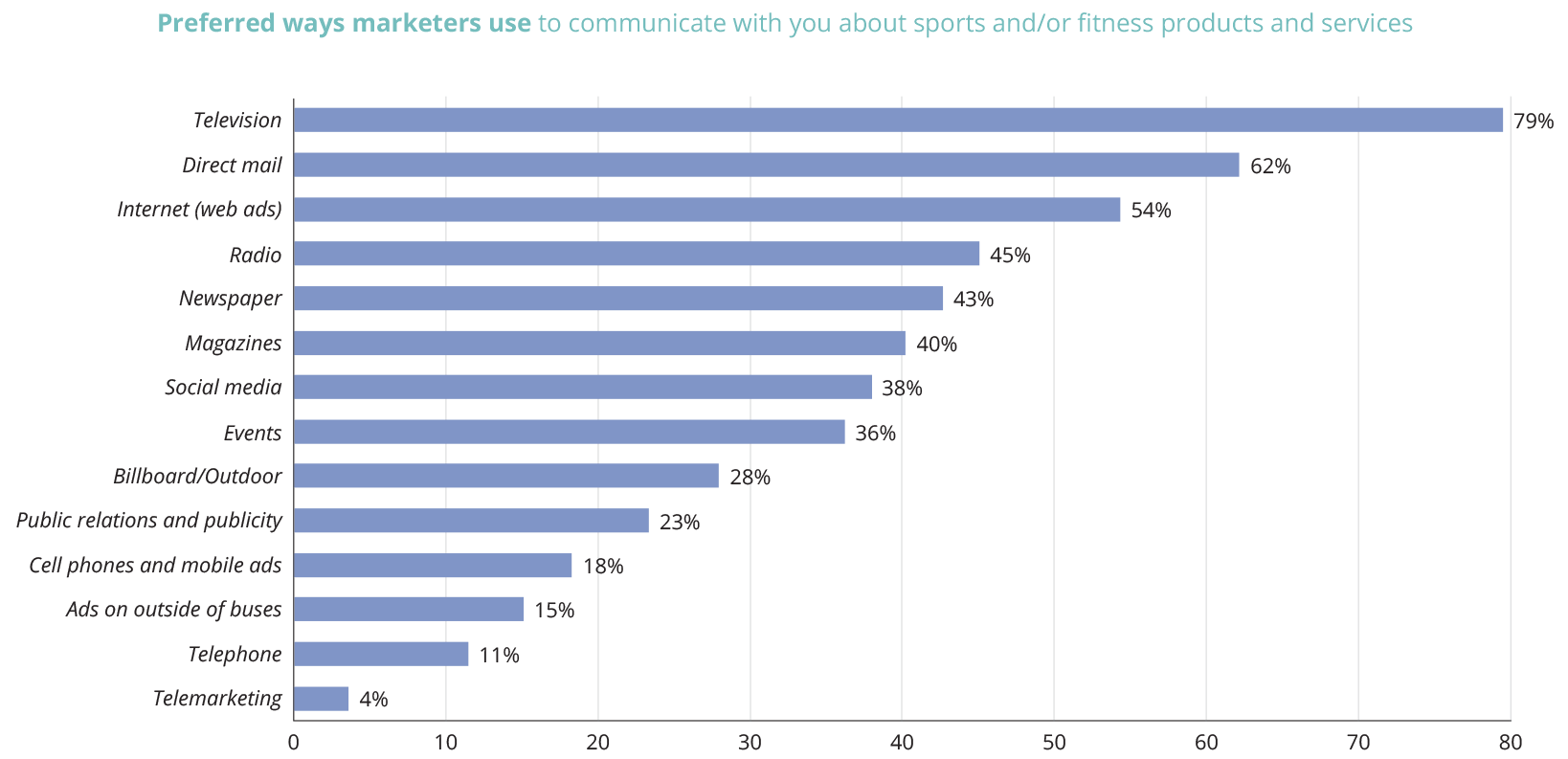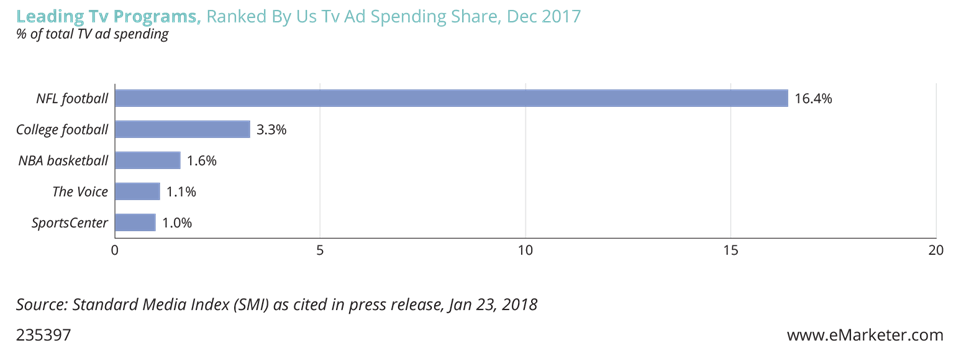Sign up for our LAVY email
and get our bi-monthly newsletter.
This article is a brief abstract of our exclusive study that takes the guesswork
out of sports sponsorship, advertising and marketing.
Download the complete 2018 Southwest Sports Marketing Report
If you want to reach sports fans, you need to be on television. Sure, we spent a reasonable amount of time and money to verify scientifically what intuitively many marketers already know. Collectively, they spent more than $10 billion last year on television ads sponsoring sporting events alone.
Then again, because digital advertising spending surpassed television sponsorships for the first time just last year, it makes perfect sense to question whether the ongoing viability of broadcast television ads is still a wise move.

Our research confirms—with a resounding yes—that it is. In fact, nearly 80% of respondents ranked television as their preferred way to learn about sports-related products, services, memberships, and events. If your brand was among those which pitched in toward $2.4 billion spent last year to sponsor regular season National Football League games, we’re confident you already know. Even with an average cost of $505,000 per 30-second spot the opportunity to reach the NFL’s audience was well worth the investment. The same goes for the 2017 to 2018 National Basketball Association playoffs. Or any of the other sports-related programming on television, 93% of which aired live.
In short, if it’s sports, there’s an audience. The only non-sports contender in the top-five television programs ranked by ad spending in 2017 was a talent competition for singers.

Maybe that’s because sports fans, who tend to be fiercely loyal, are particularly open to messaging from brand advocates who wear their favorite jersey. From Mobil, the official motor oil of the NBA and WNBA, to Nike, Adidas and others which market performance gear, sports sponsors understand that products touted by star players are virtually guaranteed to sell.
Just ask the NBA, which earned $1.12 billion in sponsorships during the 2017–2018 season, up 31% thanks to jersey patches rolled out this year. The new patches, sewn in on the left shoulder, allow companies to have their logos seen prominently throughout the game.
Why do these ads work? Here’s a sampling of reasons respondents said they personally prefer to consume them on television:

Not everyone, however, is tuning in. And there will always be those among them who prefer to skip your carefully crafted ads rather than pay attention.
Overall, an estimated 196.3 million adults nationwide watched pay TV (cable, satellite or telco) last year, down 2.4% from the year prior. By 2021, eMarketer predicts, that total will have fallen nearly 10% compared to five years earlier. The number of pay TV viewers who are 55 and older will continue to rise, while every other age group will decline.
“Younger audiences continue to switch to either exclusively watching OTT video or watching them in combination with free TV options,” said Chris Bendtsen, senior forecasting analyst at eMarketer. “[In 2016], even the Olympics and presidential elections could not prevent younger audiences from abandoning pay TV.”
OTT stands for over the top, which refers to providers such as YouTube TV, Hulu and Facebook Watch.
So, if you can’t reach everyone on TV, and certain age groups are less likely than others to watch, what’s a strategic sports marketer to do?
You send mail.
That’s right. Surprisingly, 62% of respondents ranked direct mail as their preferred way to learn about sports and fitness. While it might not seem as sexy compared to a plethora of new ways to advertise using technology, respondents ranked it solidly in second place.
While it’s easy to overlook, due to the cost of sending something physically compared to delivering messages digitally, mail is still a major player. The United States Post Office (USPS) in 2017 reported having delivered 121.2 billion pieces of mail to domestic households. In addition, the Direct Marketing & Data Association found that 42% of those who received one of the 9.8 billion catalogs the USPS mailed in 2016 read them. This squares with a Forbes article which cited a 2016 Direct Marketing Association analysis of Bizo and Epsilon data showing direct mail open rates outrank those for email, at 4.4% and 0.12% respectively.
And it gets better. More than 100.7 million adults who received a catalog placed an order.
Here’s a sampling of reasons our respondents said they prefer to learn about sports and fitness through direct mail:
Unsurprisingly, the internet (web ads), cell phones/mobile ads and social media ranked high among younger audiences, as a preferred means to learn about sports and fitness.
For millennials (respondents 35 years and younger), the preferred way to learn about sports and fitness is the internet (74%), social media (84%), and cell phones/mobile ads (54%).
This is in contrast to the overall voice of respondents who preferred the internet (54%), social media (38%), and cell phones/mobile ads (18%).
When it comes to the preferred method of activating sports sponsorships, sponsorship.com reports that social media came out on top. Kia, for example, was the 2017–2018 title partner of the Kia NBA Tip-Off, which was featured in social campaigns along with those for broadcast and digital audiences. PepsiCo used social media during fourth quarter 2017 to support its Ruffles-branded contest for prizes ranging from tickets to NBA Store gift cards and electronics. And Express used social combined with digital to support in-store promotions of its “Game Changers” campaign featuring NBA players as brand advocates.
Here’s how sponsorship.com ranked social media compared to other methods of activating sports sponsorships:
Meanwhile, here’s a sampling of what our respondents shared regarding their preferences for sports and fitness ads online and on mobile:
Internet Web Ads
Cell phones and mobile
Here’s a sampling of consumer insights our respondents shared regarding the remaining options in our study:
Radio – “Because I am trapped in my car listening to the radio and when a radio personality that I like endorses something, I tend to want to try it.”
Newspaper – “I read the paper every day and usually pay attention to the ads, so if I am interested in purchasing something, I have an idea what the cost would be.”
Magazines – “I can read it on my time and have it for reference.”
Social Media – “Most of the athletes I follow participate in events I would be interested in, so using social media through them would be effective.”
Events - “If a company sponsors an event, I'm more likely to take them seriously.”
Billboard – “When I drive around town, I do read billboards” and “You have no choice but to see it.”
Public relations and publicity - “I would pay more attention to public relations and publicity than I would advertising.”
Buses – “I ride the bus a minimum of five days each week.”
Telephone – “I could have a person to chat with.”
The main takeaway is that it pays to sponsor sports. And fans prefer that you do so on television. So, recruit that talent, create those spots, and cash in on the returns.

This article is a brief abstract of our exclusive and authoritative study that takes the guesswork out of sports advertising and marketing. Rather than speculating about what will drive consumers to action, we've asked them.
Sign up for our LAVY email
and get our bi-monthly newsletter.